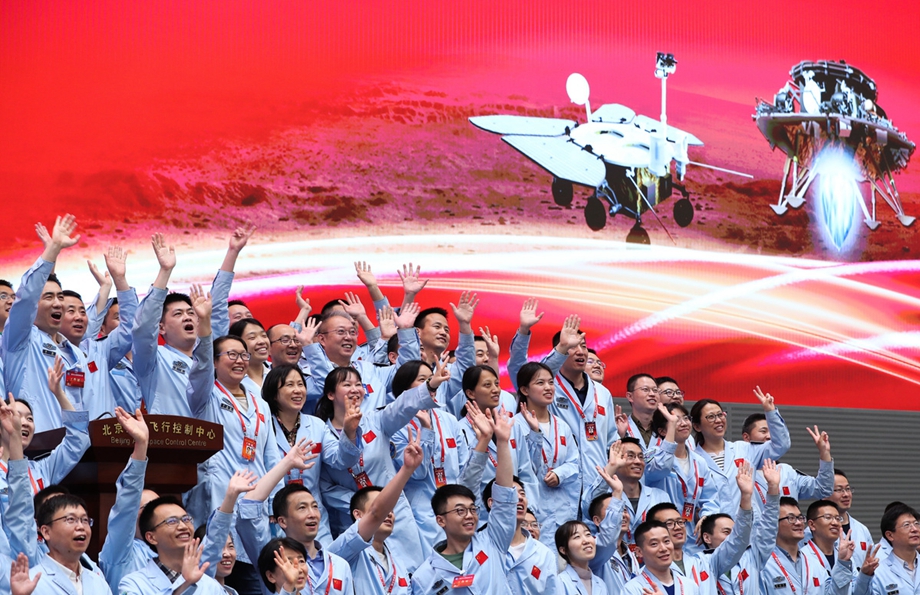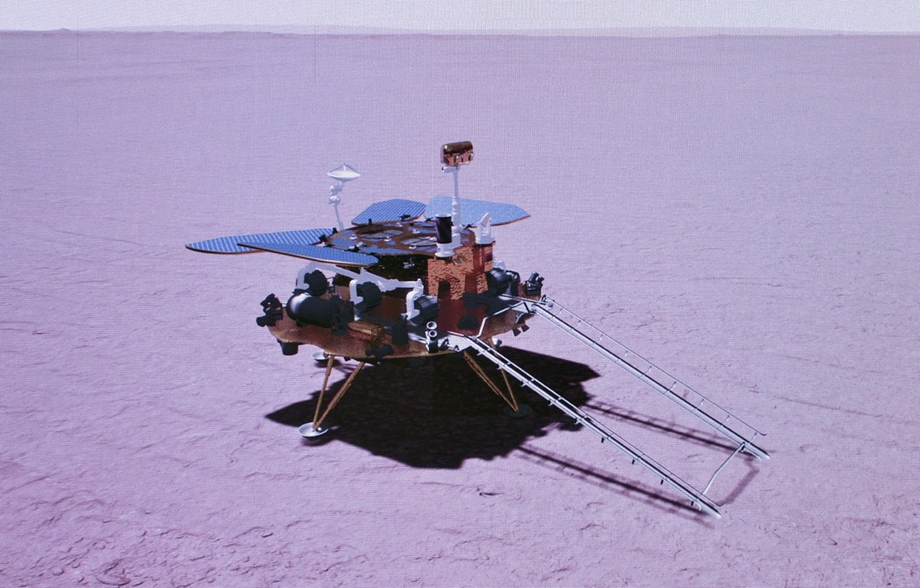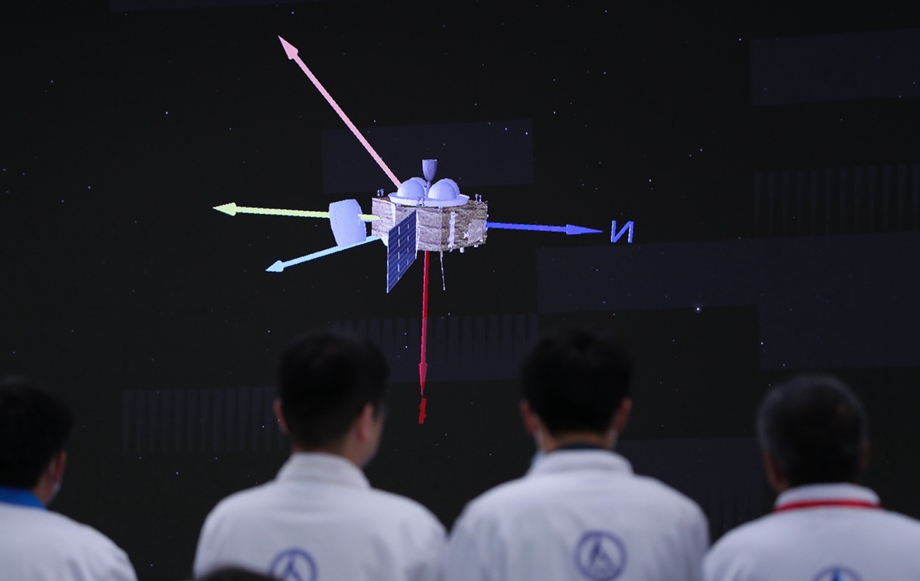Probe makes historic landing on Mars

Space program team members celebrate on Saturday at the Beijing Aerospace Control Center after the successful landing of China's Tianwen 1 Mars probe on the Red Planet was announced. [Photo by Jin Liwang/Xinhua]
A Chinese spacecraft successfully landed on the surface of Mars on Saturday morning, marking a historic accomplishment in China's space endeavors and making it the second country in the world to achieve the feat.
President Xi Jinping, who is also general secretary of the Communist Party of China Central Committee and chairman of the Central Military Commission, sent a letter soon after the successful landing was announced at the Beijing Aerospace Control Center, extending congratulations and greetings to all those involved in the landmark mission.
The letter read that the Tianwen 1 mission has left the nation's first mark on the Red Planet and is another landmark achievement in the development of China's space industry.
"Thanks to your courage in the face of challenges and pursuit of excellence, China is now among the leading countries in planetary exploration," Xi said in the message. "The country and people will always remember your outstanding achievements."
He encouraged those involved to continue working hard in the mission's next steps.
Vice-Premiers Han Zheng and Liu He were at the Beijing Aerospace Control Center in the capital's northwestern suburbs on Saturday morning and met those involved in the landing operation after Xi's letter was read.
The touchdown of Tianwen 1 on Mars was the latest example of China's rapidly expanding presence in outer space, following a string of recent accomplishments that include putting the first section of the country's permanent space station into orbit, returning the first lunar samples to Earth in more than four decades and completing a global navigation satellite network.
"Each and every step during the entry, descent and landing processes was executed with perfect accuracy," Wu Yanhua, deputy director of the China National Space Administration, told China Daily at the Beijing Aerospace Control Center after the spacecraft's touchdown.
Wu said that more than half of the over 20 Mars landing attempts made by spacefaring nations so far failed due to the exceptionally difficult nature of such maneuvers.
Tianwen 1's rover, which is named Zhurong, after an ancient Chinese god of fire, is scheduled to observe and map the landing site and to perform diagnostic tests in the coming days, he said.
Zhurong will move from its landing module onto the Martian soil to begin scientific surveys, the official said, adding that the first photos to be taken by the rover are expected to be transferred back to Earth around the end of this month.
Geng Yan, a senior planner for China's deep-space exploration programs at the space administration, said Saturday's landing was a serious test for the country's capabilities in science, technology and engineering.
"Such a challenging attempt is characterized by a succession of complex activities that must be conducted completely by the spacecraft within a very short period of time," he said. "What added to the difficulties was that we don't know much about the Martian atmosphere, which brought a lot of uncertainties to the mission."
[page]

A simulated image of the Tianwen 1 Mars probe on the surface of Mars. [Photo by Jin Liwang/Xinhua]
Sophisticated maneuvers
The Tianwen 1 robotic probe activated some of its engines around 1 am on Saturday to move closer to Mars, according to the China National Space Administration. At about 4 am, the craft separated into two parts-the landing module and the orbiter-and the landing module continued to fly toward the Martian atmosphere.
Three hours later, the module, which contained Zhurong, entered the Red Planet's thin atmosphere at an altitude of about 125 kilometers, embarking on the riskiest and most challenging nine minutes of the entire Tianwen 1 mission.
Due to the long distance between Mars and Earth, which stood at about 320 million km on Saturday, and the resulting delay in signal transmission, the whole entry-descent-landing procedure had to be carried out autonomously by the landing module based on a preset program and data obtained by its sensors.
Following a predetermined pro-gram, upon entering the atmosphere, the capsule would first use a heat shield to decelerate, slowing the craft by aerodynamic drag. It would then deploy a parachute to further reduce speed and drop the heat shield. Next, the craft would unfold its four landing legs, drop the parachute and ignite its retrorockets at 1.5 km above the Martian surface.
At about 100 meters, the module would suspend its descent and check the landing spot for obstacles such as rocks. The module would then continue its descent until it reached very close to the surface and the retrorockets shut down and the capsule would touch down.
The capsule successfully landed at 7:18 am on the southern part of the Utopia Planitia, a large plain in Utopia, the largest known impact basin on Mars and in the solar system, the space administration said.
The site was selected because scientists determined that it has suitable terrain and weather for a landing, and is also highly likely to have been part of an ancient Martian ocean, making scientific research extremely worthwhile.
If it rolls safely onto the Martian soil and works as planned, Zhurong will become the sixth rover deployed on Mars-following five US spacecraft-and will give Chinese scientists their first opportunity to closely observe Mars.
Sun Zezhou, chief designer of the Tianwen 1 probe, previously explained that a rover will have to overcome an array of difficulties on Mars, such as disturbances in sunlight reception and extreme weather, in order to survive and operate.
He said the Chinese rover has been programmed to inactivate under extreme circumstances and reactivate itself when it is safe to do so.
Zhurong is 1.85 meters tall and weighs about 240 kilograms. It has six wheels and four solar panels, and can move at 200 meters an hour on the Martian surface. Among the six scientific instruments it carries are a multispectral camera, a meteorological sensor and ground-penetrating radar.
If the semi-autonomous vehicle functions efficiently, it will work for at least three months and undertake comprehensive surveys of the planet.
Its success would mark the completion of all of Tianwen 1's mission objectives-orbiting Mars for comprehensive observation, landing on the planet and deploying a rover to conduct scientific operations. This would make Tianwen 1 the first Mars expedition to accomplish all three goals with one probe.
The Tianwen 1 orbiter has returned to its parking orbit and will continue circling the planet for mapping and measurement with seven scientific instruments, including a high-resolution imager and magnetometer. It also relays signals between ground control on Earth and Zhurong.
[page]

Technical personnel work at the Beijing Aerospace Control Center in Beijing, May 15, 2021. The lander carrying China's first Mars rover has touched down on the red planet, the China National Space Administration (CNSA) confirmed on Saturday morning. It is the first time China has landed a probe on a planet other than Earth. [Photo/Xinhua]
Lengthy journey
Tianwen 1, named after an ancient Chinese poem, was launched by a Long March 5 heavy-lift carrier rocket on July 23 from the Wenchang Space Launch Center in the southernmost island province of Hainan, kick-starting China's first mission to another planet in our solar system.
Propelled by a mixture of 48 large and small engines, the spacecraft rocketed more than 470 million km and carried out four midcourse corrections and a deep-space trajectory maneuver before entering the orbit of Mars on Feb 10. At that time, Mars was 193 million km from Earth. Because the two celestial bodies keep moving in their own orbits, a Mars-bound spacecraft must fly in a carefully calculated, curved trajectory to reach Mars.
On Feb 24, Tianwen 1 entered a preset parking orbit above Mars. The spacecraft was programmed to maintain that orbit for about three months to examine the preset landing site.
Tianwen 1 is the 46th Mars exploration mission since October 1960, when the former Soviet Union launched the first Mars-bound spacecraft. It followed the US' Mars 2020 mission, which has already deployed a rover, named Perseverance, and the first Mars-based rotorcraft, called Ingenuity.
Only 19 Mars missions so far have been considered successful.
Eight Mars orbiters are in active service as well as three operational rovers-the US' Curiosity and Perseverance and China's Zhurong.
Zhang Rongqiao, chief planner of the Tianwen 1 mission, said on Saturday that China has started planning for a sample-return mission to Mars, a task not yet achieved by any country.
Mars, one of the four terrestrial planets in the solar system and the most similar to Earth, is the most favorable destination for deep-space exploration. It also fires the imagination-among all scientific topics, people seem to be most enthusiastic about searching for life on other planets and an eventual attempt at interplanetary immigration.